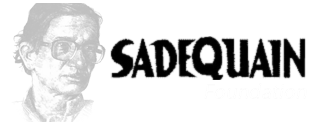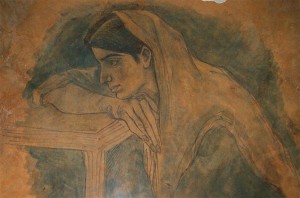

 It is said that drawing skill is as essential for an artist as the knowledge of alphabets is to a writer. Sadequain skillfully sketched pen and ink portraits starting at age 14 or earlier and regularly drew portraits of people on the trains when he traveled in early 1950s between Karachi and interior parts of the Sindh province, street corners, his close friends, and most of his household members. In a world where artists gain credibility by doing portraits of those who can afford to pay handsomely, Sadequain’s pure passion was to employ his skills to service those who could not afford it.
It is said that drawing skill is as essential for an artist as the knowledge of alphabets is to a writer. Sadequain skillfully sketched pen and ink portraits starting at age 14 or earlier and regularly drew portraits of people on the trains when he traveled in early 1950s between Karachi and interior parts of the Sindh province, street corners, his close friends, and most of his household members. In a world where artists gain credibility by doing portraits of those who can afford to pay handsomely, Sadequain’s pure passion was to employ his skills to service those who could not afford it.
He had an uncanny ability to capture the facial expressions since early age, which are so important to portray the feelings of the subject. However, in his entire career he did not wander off to commissioned portrait drawings or drifted to landscape paintings. But his early work, which includes a number of unconventional portraits, demonstrates his ability to capture the intensity of human emotions. His portrait work of the1950s represents the skillful study of human face – a necessary skill for an artist – displayed in pencil work and oil paintings.
His ability to study the personality of his models and his innat e talent to transform his observations onto canvas is self evident. The ubiquitous face in Sadequain’s paintings, murals, and drawings is his own, drawn wretched, deformed, and tortured, with self-evident agony in most cases. In his own way, when he drew his portraits, Sadequain perhaps intended to pay homage to Picasso, who redefined the art of portraiture. Picasso’s works and many Sadequain’s works are self-portraits of varying kind. Most of Sadequain’s portraits that are on record with the SADEQUAIN Foundation now are that of his close ones – his mother, brothers, sister in law, cousin, or niece.
e talent to transform his observations onto canvas is self evident. The ubiquitous face in Sadequain’s paintings, murals, and drawings is his own, drawn wretched, deformed, and tortured, with self-evident agony in most cases. In his own way, when he drew his portraits, Sadequain perhaps intended to pay homage to Picasso, who redefined the art of portraiture. Picasso’s works and many Sadequain’s works are self-portraits of varying kind. Most of Sadequain’s portraits that are on record with the SADEQUAIN Foundation now are that of his close ones – his mother, brothers, sister in law, cousin, or niece.
One of the revealing portraits is that of Saiyid Ali Naqvi, his cousin and a close confidant, seated on a chair. The expression, posture, and personality is so well illustrated in the portrait that it appears – in the proverbial sense – he is ready to stand up and walk away. The book, SADEQUAIN: The Holy Sinner describes the portrait of his mother, “The beautifully somber portrait of the artist’s mother is proof that its creator could have been a great portrait painter had he so wished. Sadequain was deeply attached to this penetrating and loving portrait and it stayed hidden by his side till he died.” It must be noted that the night Sadequain passed away, this portrait was stolen from his hospital room. It is not certain who has it in his possession now, but what is certain is that Sadequain’s family has been deprived of a sentimental family heirloom.
Another stunning portrait is that of his niece Nasreen, which was executed impromptu, on one late night after the electricity went out, while he was playing cards with his nieces and nephews. The group not ready to retire uet, lit up candles and engaged in idle talk and told jokes until Sadequain noticed Nasreen sitting on the floor, leaning against a chair in a restful repose. She was sleepy, but conscious in a peaceful stance. Sadequain picked up a piece of sheepskin, found the markers that were close to him and unknown to Nasreen, drew her haunting image in contemplation with a few strokes within a few minutes. This was the last time he saw Nasreen, who returned to the USA in the morning and a few days later had a life ending car accident in Denver Colorado in 1981. The portrait is a reminder of Sadequain’s premonition.
His line work in portraiture drawing is characterized by strong lines defined by continuous and unidirectional motion of the instrument, applied with uniform pressure, and without a trace of corrective action. Whether doing a casual portrait, or a detail study of a subject, the force and clarity is always evident. In many cases he used to draw a series of similar drawings to study the subject from various angles and under different conditions. These drawings, sensuous in many cases, demonstrate his skill and imagination, and often serve as a dry run for his paintings or murals. A quick reference of his collection of rubaiyyat titled, Rubaiyyat-e-Sadequain Naqqash with illustrated drawings will reveal many examples, which are an integral part of his portfolio.